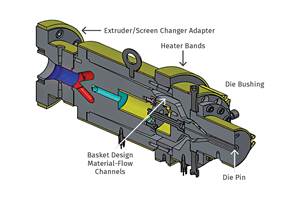Not Running, But Still Pushing Technology Envelope in Film Extrusion
W&H sees options in retrofitting game-changing quick-switch technology.
Used to be, you’d see about as many running blown-film lines at NPEs as you would at the K Show. But while many builders of blown-film lines still operate systems at the giant triennial show in Dusseldorf—some more than one—most have scaled things back where NPEs are concerned, citing the cost of resin and power, as well as the “impracticality” of how to dispose of finished rolls.
But that’s not to say there aren’t some interesting things to see and talk about in Orlando. In the case of Windmoeller & Hoelscher Corp., (Booth W6663), retrofits will be a big theme. The company has made its revolutionary TurboClean technology automation module retrofittable to some existing W&H lines. The TurboClean system purges resin from all extruders and gravimetric hoppers simultaneously, dramatically decreasing the time required to change materials. It was introduced at an open house W&H held at its Lengerich, Germany headquarters in mid-2015, then officially unveiled at K 2015, but was available only on new W&H Varex II systems.
But now, existing W&H Varex II and Varex I lines built in or after 2010 can be retrofitted with the module, allowing blown film processors to benefit from significant cost savings via faster job changes. With TurboClean, material changes are almost completely automated. Operators no longer need to manually purge resin one extruder at a time. Instead, the work steps are automated and run simultaneously, requiring the operator only to change the suction wand from one resin port to the next. This system is said to reduce the time it takes between product changeovers from 30 min to an astounding two min.
“W&H commercialized the industry’s first automatic gauge-control technology in the late 1980s with the Optifil P system, and the TurboClean is yet another example of our efforts to take scrap out of the blown-film process,” states Andrew Wheeler, president of W&H Corp. Some film structures contain not only multiple layers, but each layer can be comprised of a half dozen or more different material components. “Smaller companies in particular—film processors with three to five lines—will get a very quick return on investment on TurboClean,” Wheeler states. “If they do shorter runs and make multiple changes a day, TurboClean will pay off very quickly.” But the technology is also suited to larger-sized processors with much longer run times. “These film processors are concerned about pounds, pounds, pounds,” says Wheeler. “They might do one or two changes a day. But by compressing the time between changes, they are freeing up machine time and might be able to fit in another order.”
Wheeler reports that W&H has lines equipped with TurboClean installed (or on order) in North America.
Wheeler also notes more processors investigating mid-size Machine Direction Orientation, improving properties by adding 5-10% stretch post-processing. On the matter of Industry 4.0—or Packaging 4.0, in W&H’s parlance—Wheeler notes Filmex II cast film lines are being furnished with its recently introduced Film Performance Monitor (FPM). “We’ve been pushing the idea of networking machinery for a long time in extrusion, and we’re seeing more customers gearing up for it. FPM integrates data from the extrusion line with downstream converting equipment, allowing these two previously discrete operations to be networked to improve quality and make the entire production process seamless and traceable.”
Related Content
Single vs. Twin-Screw Extruders: Why Mixing is Different
There have been many attempts to provide twin-screw-like mixing in singles, but except at very limited outputs none have been adequate. The odds of future success are long due to the inherent differences in the equipment types.
Read MoreHow to Select the Right Tooling for Pipe Extrusion
In pipe extrusion, selecting or building a complementary set of tooling often poses challenges due to a range of qualitative factors. Here’s some guidance to help you out.
Read MoreRoll Cooling: Understand the Three Heat-Transfer Processes
Designing cooling rolls is complex, tedious and requires a lot of inputs. Getting it wrong may have a dramatic impact on productivity.
Read MoreTroubleshooting Screw and Barrel Wear in Extrusion
Extruder screws and barrels will wear over time. If you are seeing a reduction in specific rate and higher discharge temperatures, wear is the likely culprit.
Read MoreRead Next
See Recyclers Close the Loop on Trade Show Production Scrap at NPE2024
A collaboration between show organizer PLASTICS, recycler CPR and size reduction experts WEIMA and Conair recovered and recycled all production scrap at NPE2024.
Read MoreMaking the Circular Economy a Reality
Driven by brand owner demands and new worldwide legislation, the entire supply chain is working toward the shift to circularity, with some evidence the circular economy has already begun.
Read More




















